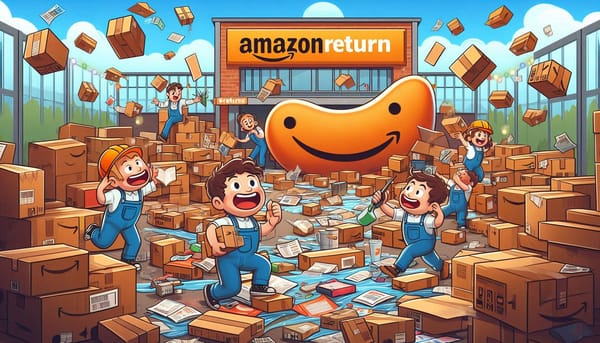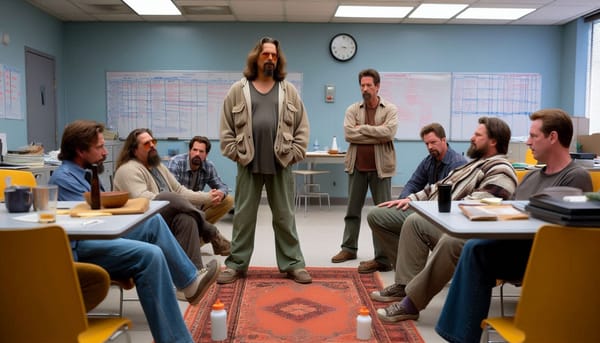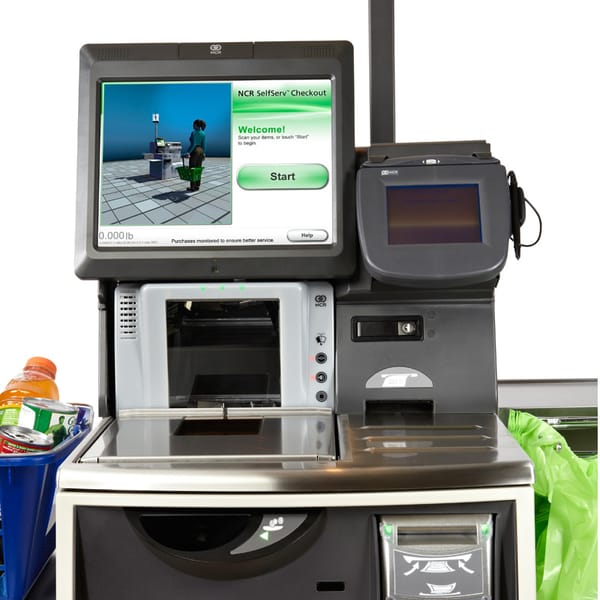Story Time: Being Deposed Part I
The vast majority of product managers will never be seated at a table with advocates grilling them under oath, and with the video cameras rolling, but it does happen, and it sucks

Twice in my career I have found myself at the end of a table with opposing counsel asking difficult questions. Once it was a 30 (b) 6 deposition, where I was the corporate designate, and once it was in the aftermath of an OEM agreement that went to hell in a hand basket.
This post is for the second one. A future story will recount the other one.
The TL/DR: There are no informal meetings when lawyers are involved, if you are asked to attend a meeting come armed with an attorney you are paying, and resist the urge to use side channel communications. That shit will ruin you.
Now strap in for a lot of (necessary) technobabble to set the stage.
The OEM Agreement
Circa 2008 I was working for a company that made high performance surface topology measurements without contacting the surface. Our technology used interferometry techniques to yield ultra high resolution surface topology measurements.
Interferometry uses a single beam of light, split to travel two paths, and then when they recombine, the interference patterns can be interpreted to yield distances point by point.
There were two variants, phase shifting interferometry, where we used a single wavelength, and it gives surface heights that are accurate to within a small fraction of a wavelength. So for red light (633nm1, as in a HeNe laser) it truly provided accuracy on the order of 5nm, and gage repeatability much less than a nanometer.
The principal users of this technology was the makers of computer disk read/write heads, where there are some features called air bearings that are very specific geometries, and the heights of the relative surfaces are critical to a parameter of the disk - the fly height2.
This was far and away our most important market segment. But we also had a second technology, white light interferometry. Instead of a monochromatic illumination source, we used a halogen bulb, and as you surely remember from your high school science classes, white light isn’t really white, but instead it is all the wavelengths of visible light. This sacrificed some of the gage repeatability, but it absolved the technique of one serious limitations. PSI, being monochromatic, meant that you could only detect deviations in fractions of a wavelength. Otherwise, the fringes (interference effects) would repeat, and you get ambiguity. Any metrologist knows that ambiguity is the death of measurement.
White light interferometry (WLI) solves this conundrum, and makes the technique applicable to a lot of segments that PSI isn’t useful for.
In summary, WLI trades some of the Gage R&R for range, yet retains quite good accuracy.
This gets us to the second issue (sorry, this is getting long for intro material, I apologize) that having an interferometer in the path between the microscope objective and the surface being measured takes space. And space means long working distance objectives, and either Fizzeau (the classic 90 degree interferometer, c.f. Michelson-Morley experiment) or Mirau where the beam splitter is coincident with the optical path requires millimeters to fit the apparatus into the optical path.
This is a downside, it means that resolution will be limited, as resolution is not tied to magnification (a common misconception) but instead to the numerical aperture (NA) of the objective, and to get more working distance, you get less resolution. There is also something about relative angles of capture, but suffice it to say that if you are looking at steep slopes, low NA is your enemy. But the benefit of interferometric techniques is that the vertical resolution (that is height discrimination at each pixel) is the same regardless of the magnification/NA. That is tied to the physical properties of light.
Getting to the point
There is another technology for measuring surface topology with light. It is confocal microscopy, that uses pinholes (or lasers + pinholes) to only detect light from the sample when it is in perfect focus. If you scan a surface with these pinholes while going through focus, you can read the relative height of each pixel when you get a response on the camera. Go through focus and you can build up a topographical height map of the surface in question.
The pros are many. You do not have an interferometer in the optical path, so you can get closer to the surface. And a 100x objective, with a 0.95 NA (1.0 is the theoretical maximum, .95 is about as good as you can get in air) is about 0.3mm. That is pretty damn close to the surface. But you get good Rayleigh Criteria resolution that is about 1/2 the wavelength of the light used. If you are using a 430nm purple-ish laser, you can resolve things about 200nm. Pretty damn good.
But you have another problem. The accuracy of the focus is more relevant than the light or the objective. It is tied to mechanical measurements of the focus element, and serious microscopists know and understand this. Additionally, the depth of focus is tied to the microscope objective, and when you change objectives to get a larger field of view, you get a larger depth of focus and that exacerbates the uncertainty (or increases the error in the measurement).
While you can get pretty good results with that 100X objective, if you go to 50X or 10X to get a larger field of view, your accuracy and repeatability go to hell in a hurry.
Like unusable for measurements.
The point, Finally
These two different techniques are similar enough that our sales team wanted the better resolution (and higher slope capabilities) of Confocal, and they constantly told us that we needed to build a system for them.
No matter how much I explained to them of the differences, and how unsuitable the confocal technique was for our market(s), they pounded on the table.
We were looking at building a confocal system to shut them the hell up. But, earlier in my career, I worked for a small company that made a Nipkow disc confocal system, and I offered up in one of our senior team meetings that perhaps we could OEM microscopes from this company. They had a background in material science, and not just the life science side that most of the confocal companies targeted.
As I was just a PM, I made the introduction, and let our leaders get to negotiating.
It was taking a lot longer to come to a deal, but I wasn’t in the midst of it. That said, the principal of the partner who I had a long term relationship with reached out to me to see if I could provide some guidance. I made a few seemingly innocuous comments via a side channel (note: never use personal email for things like this. If you must get involved, do it above board), and the deal closed.
The microscopes arrived, the sales team got to look at them, and realized that their terror over the Olympus instrument was totally overblown, and that for our segments, confocal was shit.
No duh, I had been “educating” them of that fact for 6 years at that point.
The Lawsuit
I left not long after the OEM agreement was inked, and we had gotten the demo units in to work with. I wasn’t involved at all in the details of the agreement, but our leaders were a bit clever and included some verbiage that let them take ownership of the IP is the partner company failed.
Fairly standard stuff between big companies, but this is the nuclear option. Turns out that the clause was exercised, and the payout to the supplier was meagre (or some such shit, I never read the lawsuit, nor was I given a copy of it) but since I had been the “greeter” making the introductions, I got called to be deposed.
No biggie. I was working for a different company, not even in the same market. I found an excuse to travel to the Bay Area for some meetings with the mothership, and agreed to extend my stay by a day to talk to the lawyers.
I expected it to take a couple of hours, to have lunch with an old friend, and then catch a plane home in the afternoon.
No, that is not what happened.
The Grilling
We started promptly at 9:00AM, and I was greeted by the opposing counsel (we met in their office - that is red flag #1) and immediately this went in a bad direction.
I expected a congenial discussion (that is what was promised), and instead it was a formal deposition. Steno, video cameras, counsel for the plaintiff, counsel for the defense, on the other side of the table.
Over the course of 8 hours, I was bombarded with questions. Why did I make the introduction? What role did I play (none formally)? We got into minutia. How many units were forecasted? Where were demo centers going to be? Who was handling tech support?
All along, they had printed copies of email from me which in isolation looked damning. No before or after context.
One that still haunts me is one talking about demonstration strategies, and how we could put the confocal in the best light. When they slid that across the table to me, I blanched. It looked like playing favorites, or tipping the scale, potentially hurting the business of the supplier/partner. I was of split mind. One side of me was thinking “Wow, I used to write thoughtful cogent emails”, the other in dread panic, because this was part of a thread that provided a lot of context to make it innocuous.
Regardless, I spent 8 full hours (yes, I missed my flight and stayed another night to stew) being completely fucking grilled. My “friendly” advocate (for my former buddy’s suit) was trying as well to pin the whole shit show on me. And in the room: the representative for the company I worked for, an Executive VP, who was practically gleeful in my squirming. His smirks still sting.
Lessons Learnt
If you have personal connections to a field your company is interested in, keep them to yourself.
When there is a lawsuit involved, there are no innocuous conversations. They are landmine fields that will trap you.
Never rely on someone else’s lawyers. Spend the money and have your own lawyer there to prevent the deposition from going off the rails. My mistake was assuming that my friend’s attorney (who seemed like Wilford Brimley) Was on my side, when he was just as vested at pinning the shame and blame on my head as the other counsel.
EVP’s can be petty, small men. I will have more to say about this particular cretin, but let’s just say that he holds grudges, and my name is still mud in a field that I spent more than 15 years in.
A nm is a nanometer, or 1 billionth of a meter. A human hair is about 10,000nm in diameter ↩
Fly height is how far away from the disk the head “floats”. The dynamics (at the time) was the equivalence of a Boeing 747 flying at the speed of sound, 17 inches over the full surface of the earth, with all the mountains and topologies. The air bearing is a carefully designed geometry that helps control the fly height as the disk spins.



